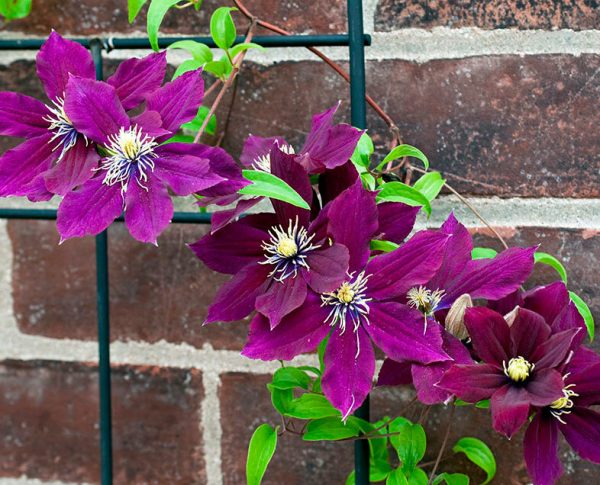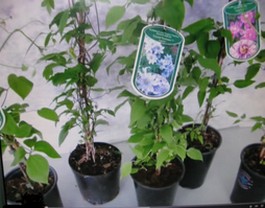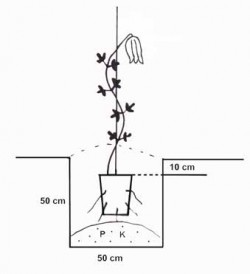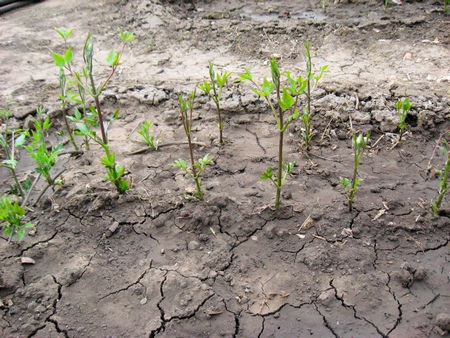Clematis cannot be called a capricious culture. However, planting clematis has one characteristic feature that is inherent in very few plants. And this feature must be taken into account
Planting clematis in the spring, as well as in the fall, is carried out with the seedlings being deeply buried. The root collar should be 10 cm below the soil level for young plants and up to 30 cm for older plants.
Of course, when planting, you need to take into account other preferences of clematis.
How to plant clematis in spring
What time in the spring are clematis planted? In most cases, seedlings are purchased in specialized stores. They are sold with a closed root system and are sometimes bought in the winter, while there is a large selection in stores.
If leaves have already appeared on such plants, then until spring, place them on the windowsill and care for them as you would for ordinary flowers. If the buds have not yet hatched, it is better to keep them in the cellar, at a temperature of 0 - + 2.
Planting plants with young shoots in the spring is allowed only after the threat of frost has passed. And for plants with open roots and dormant buds, early spring planting is much preferable; they are planted at the end of April.
Landing place. Most clematis like well-lit, sunny locations. But unfortunately, not everything is so simple. You need to take into account the region of your residence and the variety of clematis. In regions where summers are hot and dry, planting in the sun, near the southern wall of the house, or especially near an iron fence, is strictly not recommended. The plants will simply bake there. But planting in the sun in the northern regions is a very good option.
The same applies to clematis varieties. Some of them, especially those with light colors, prefer partial shade.
But what all clematis cannot tolerate is waterlogged soils. They don’t even like prolonged flooding during spring floods.
They also have an extremely negative attitude towards drafts. Thin and very fragile shoots with heavy, large flowers often break in the wind.
These plants are not particularly demanding of soil, but grow best in nutritious and light soils, with a pH < 6.5.
To summarize, the ideal place for planting clematis should be dry, well lit, but not in the sun, not in a draft, with nutritious and not acidic soil. If it is near the wall of the house, then water does not drip from above and the roots are no closer than 0.5 m from the wall.
How to plant clematis
A young bush is planted 8 - 10 cm below the soil level. Deeply planted clematis take root well, will be stronger, healthier, more resistant to diseases and pests, and will
bloom more abundantly.
Therefore, the landing hole will have to be dug quite large. If the site has fertile soil, you can simply dig a deep hole, but if there is clay or sand, then do not be lazy and prepare a spacious planting hole (50 × 50).
To ensure that the young bush is provided with everything it needs, fill it with a nutrient mixture. Such a mixture may consist of forest soil, peat, sand and humus in equal proportions. You need to add 100 - 150 grams there. com. min. fertilizers and two glasses of ash.
Clematis simply adore ash. It is good to sprinkle the ground around the bush with ash, especially in the fall before wintering and in early spring, and in the summer, water the plant with an ash solution. On acidic soils, sprinkle the ground with lime or dolomite flour every spring.
Before planting, the container with the plant is immersed in water for 10 minutes, after which it is placed in the planting hole, buried 10 cm and covered with soil. At autumn planting the hole is completely filled up, and when planting clematis in the spring, soil is poured up to the level of the root collar.
Over the course of the summer, this depression will gradually close, and by autumn, fill it up completely.This will make it easier for the seedling to adapt to a new place.
You should not expect rapid growth of shoots in the first year after planting. Initially, the underground part will develop, and it is better to cut off the above-ground part, leaving 3 - 4 buds on each shoot.
Clematis planted in spring should be protected from the sun and watered more often. If buds appear, they are removed immediately.
How to help clematis grow faster
Clematis is a perennial plant and therefore grows very slowly at first. But he can be helped
grow faster. This can only be done for 2-3 years, but not immediately after planting.
To do this, one or two shoots are lowered to the ground and 1 - 2 buds are dug in, as shown in the figure. The following year, the buried internodes take root and begin to develop as independent plants.
Everything is very simple, but you shouldn’t get carried away with it, otherwise in a few years the bush will become very overgrown.
Where to get planting material
It is not necessary to buy clematis seedlings. It is easy to make layering from existing bushes.
To do this, one or more shoots are buried in the early spring. In the summer, they make sure that the ground is moist all the time and the following spring they plant clematis that grew from the buds of a buried shoot. Read more about this in the article about the propagation of clematis.







 (12 ratings, average: 3,33 out of 5)
(12 ratings, average: 3,33 out of 5) CUCUMBERS NEVER GET SICK, I'VE BEEN USING ONLY THIS FOR 40 YEARS! I SHARE A SECRET WITH YOU, CUCUMBERS ARE LIKE THE PICTURE!
CUCUMBERS NEVER GET SICK, I'VE BEEN USING ONLY THIS FOR 40 YEARS! I SHARE A SECRET WITH YOU, CUCUMBERS ARE LIKE THE PICTURE! You can dig a bucket of potatoes from each bush. Do you think these are fairy tales? Watch the video
You can dig a bucket of potatoes from each bush. Do you think these are fairy tales? Watch the video
 How our fellow gardeners work in Korea. There is a lot to learn and just fun to watch.
How our fellow gardeners work in Korea. There is a lot to learn and just fun to watch. Eye trainer. The author claims that with daily viewing, vision is restored. They don't charge money for views.
Eye trainer. The author claims that with daily viewing, vision is restored. They don't charge money for views. A 3-ingredient cake recipe in 30 minutes is better than Napoleon. Simple and very tasty.
A 3-ingredient cake recipe in 30 minutes is better than Napoleon. Simple and very tasty. Therapeutic exercises for cervical osteochondrosis. A complete set of exercises.
Therapeutic exercises for cervical osteochondrosis. A complete set of exercises. Which indoor plants match your zodiac sign?
Which indoor plants match your zodiac sign? What about them? Excursion to German dachas.
What about them? Excursion to German dachas.
I didn't know that clematis had to be planted so deep. I planted them like all other plants, without any depth. So what should we do now?
Elena, don’t worry, let your clematis grow like this. Just shade its root zone.You can plant some flowers around the clematis or just mulch the soil and cover it well for the winter.
It is probably not worth replanting clematis planted without deepening, but in the future, keep in mind that it is really better to plant clematis deeper.
And in the photo below, is it that one buried clematis shoot produced so many shoots?
Yes, Rita, you are right, from almost every bud of a shoot buried in the spring, within a year these shoots grow - new, young clematis bushes. You can read more about the propagation of clematis by clicking on the link at the bottom of this article.
I bought clematis at the store with two rather large shoots (60 - 70 cm). If I dig in one of these shoots, then next year I will have shoots the same as in the photo? Or did I understand something wrong?
Veronica, when planting clematis, there is no need to dig up the shoots. Nothing will grow out of them anyway. I’ll tell you even more: in the first year, the planted bush itself will hardly grow and this is normal. Shoots will begin to develop well only in the second year. And propagation by layering (dropping shoots) is possible only from 3 years after planting.
And even better from 5 years after planting.
Interesting article, I enjoyed reading it.
I have a question: if the sprout has fallen off the neck, should I deepen the neck or not?
Olya, if the shoot is broken, then still plant it deeper, but don’t bury the hole. The remaining part of the shoot (or buds on the root collar) should be above the ground. In the fall, when a new shoot grows, the hole can be filled up.
I bought 2 clematis from an online store - one pot with shoots and the other with just a root in the ground. Will it be of any use or not?
Irina, put it on the window and water it. It is quite possible that it will continue to grow.